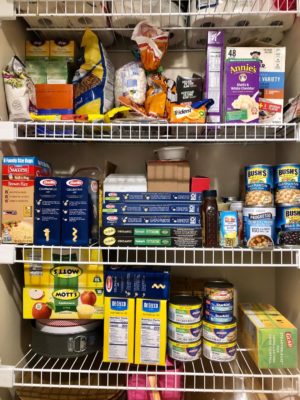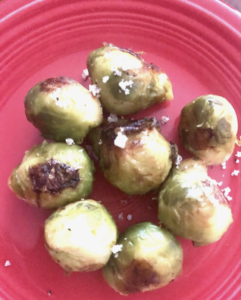Kitchen food pantry is a must whether it’s shelves or bins if you want to maintain a healthy eating lifestyle and not have to run out to the grocery store every time you need an ingredient 🤔

It’s smart these days to have a running house kitchen food pantry, especially with all the grocery store shortages and shipping dilemmas.
What you store in your kitchen food pantry ends up being part of your diet (the same concept as: what you bring home from the grocery store or delivered ends up on your plate).
So, I started a household kitchen food pantry at the start of 2020 because I’m a planner and that makes food conveniently available in real-time.
Real food is a basic need, and no metaverse can change that (zero taste would never last on our planet 😊).
Plus, having a personal kitchen food pantry lets you bypass the panic buy waves that seem to run rampant.
And you can find yourself cooking and baking more, just in case you’re looking for homemade-cooking inspiration.
But even if you’re not a planner, the checklist ✅ below can help remind you of healthy pantry food items to stock up on when you’re running low.
One recent item I found interesting that made the trending grocery shortage list along with chicken is cinnamon buns.
Cinnamon I think I sweet, and no heat, but if you’re not used to it, can kinda feel that way.
Ceylon cinnamon is the kind you want to add to your healthy beverages. The regular or traditional cinnamon is Cassia cinnamon that’s often used in baking.
So, anyway… Here’s a kitchen food pantry idea list that can come in handy (from my pantry to yours maybe?):
✔️ Nuts, Seeds, and Dried Fruits (ex: raisins, craisins, dates, papaya, almonds, walnuts, sunflower seeds, flax seeds) come in handy as snack fillers between meals. You can make a trail mix or use them to bake with.
They’re dry ingredients so they water down baking, that’s working to dry what’s baking in the oven. If you have temperature-sensitive nuts like macadamia or Brazil nuts, you can keep them in the fridge to give them a longer life.
✔️ Canned Beans and Other Legumes (ex: white beans, black beans, peas, edamame, chickpea-garbanzo beans) you can use for every meal or straight out of the can.
You can run water inside the open cans to rinse out some of the preserving salts/sodium, or you can use the can liquid for soups and dips. You can even use the chickpea aquafaba liquid as an egg white substitute. There are no rules. But once cans are opened, it’s smart to refrigerate and use ’em within a few days.
✔️ Packaged Fruit (or what I call pantry shelf fruit, ex: unsweetened applesauce, cherries, pineapple) come in handy for baking.
Btw, I try to buy the unsweetened (or unsalted) versions if there’s a choice for all food goods ready-to-eat or for baking. ‘Cause then you can choose what sweets or salts to add back in, and control how much. And that’s part of the benefits making your own bakes and dishes.
✔️ Canned Proteins (ex: tuna, sardines, clams) make great snacks and lunch meat. You can add to almost any carb meal.
✔️ Shelf-ready Non-dairy milks (ex: almond milk) are good to keep around, plus a can of coconut milk and evaporated milk for easy baking or soups. Best expiration dates are usually over a year out.
✔️ Comfort Food Boxed Pasta make a pantry shelf look organized (that probably wasn’t your first thought, lol). There seems to be a new pasta shape out every year and in panic-buy shortages, the whole aisle empties fast (and ends up in pantries!).
So it’s good to have a couple of uniform boxes with different pasta shapes on hand. Larger pasta surfaces like shells will hold onto sauces better when you’re deciding what shapes and types to go with (ex: traditional spaghetti, macaroni, whole wheat).
Veggie pasta doesn’t need a fancy sauce and can taste light and elegant with the right EVOO.
✔️ Canned Tomatoes or Tomato Sauce go hand and hand in your pantry for a weekly Italian meal. But the cheese doesn’t belong there and I agree with the Italians that parmesan (America’s cheese) is not high quality once you get a taste of the better stuff.
You can opt to store nutritional yeast as a dry, cheesy alternative. It’s called “nutritional” because it’s full of nutrition (vitamins and minerals).
✔️ Slow Cooking or Old-Fashioned Oats and Grits. Good for breakfast but they can be substituted instead of flour for some bakes, and if you want to do gluten-free.
✔️ Other Whole Grains: (ex: brown rice, quinoa, barley, farro). Just look for “whole” in front of grains.
✔️ Drinks: (ex: unsweetened cocoa for baking and hot cocoa and ground coffee.) Even if you don’t drink these often they come in handy for occasions. You can always make healthy cold brew coffee if you don’t have a coffee machine.
The best drink for your body (water) isn’t in the pantry.
✔️ High Bran/Whole Grain Cereal: Processed cereals (including fortified ones) have gotten a bad rap. Some you may have heard we grew up with are even linked to having traces of weedkiller.
But if you find the right fortified cereal, that can be a good daily fiber source and a possible better sweet substitute.
✔️ Chocolate chip morsels: You can always find some chocolaty-way to bake them in or enjoy in a no-bake trail mix.
I learned in my Doubletree catering management experience that chocolate chips will get you far… and chocolate chip cookies will get you even further! 🍪
This is the easy and healthy low sugar chocolate chip oatmeal cookie version and a cool-star cookie design chocolate oatmeal soft recipe.
And of course sugar is paired well with none other than salt…
✔️ Salts: (ex: kosher, coarser sea salt, regular sea salt). Kosher is good for some bakes while coarser salts are a great finishing touch for veggies (almost like a salt garnish).
They allow you to appreciate your foods better at the moment when they activate on your tongue ...remember the different taste regions on the tongue?

✔️ Vinegars/Condiments: (ex: apple cider vinegar, red wine vinegar, white wine vinegar, Worcestershire, and soy sauces).
These are versatile ingredients you can use to dress up your dishes, dressings, and sauces.
✔️ EVOO: keep a medium and a lighter version for cooking vs. baking (if you like the scent and taste, chances are you’ll love it in your dishes).
✔️ Flours: all-purpose, whole wheat, bread, corn, gluten-free (ex: almond, coconut, and buckwheat can be used in baking). Gluten-free flours are better preserved in the fridge than in a pantry.
✔️ Baking agents: cornstarch, baking powder, baking soda-the orange box in your fridge not to be confused with slightly different baking powder in baking, yeast packets for breads, sugars sparingly used for baking (ex: powdered sugar, monkfruit sugar, and brown sugar). You can learn to add less sugar and crave less.
✔️ Soup: before 2020, I used to buy canned low-sodium soups, and learned to cut down the sodium even more by making soups adding your own amount of salt, and from fresh kitchen food pantry ingredients.
With fresh and root veggies, you can almost make any kind of warm soup you want. Same concept with fresh fruits where you can make no-added sugar juices and low-sugar orange juice.
✔️ Variety of anti-inflammatory herbs and spices: for every day you want to have a variety of spice such as: oregano, turmeric, cayenne, cumin, black pepper, cinnamon.
For Thanksgiving and Christmas holidays, you want to take a look at your spice options, and add spices such as thyme, rosemary, nutmeg, anise, allspice, cardamom, cinnamon, ginger if those aren’t fresh.
✔️ Loose leaf and tea bags: from an herbal list, peppermint is always good to have on hand for aches.
Floral and fruity tea is also favorable. Black (ex: cinnamon, Earl Grey, chai), green, and red/rooibos are antioxidant wonders.
✔️ Breads: Where is the best place to preserve bread longer… pantry, fridge, or freezer?
It’s the freezer. The fridge hardens and dries out your bread, but a freezer will keep it from undesirable changing properties after 2-3 days at room temperature.
You’ll know when freezer bread has eventually turned stale as it has a freezer-burn, cardboard-like but that doesn’t usually happen for months or longer.
If you’re wanting to freeze bread, slice it up at room temperature first before freezing, so you can pull out the slices you need without de-thawing the entire loaf.
Pop frozen toast in your toaster, and it’s just as fresh.And with the list above you have your own pantry where you can make fresh home bakes and meals. That’s something to be happy about 😊
